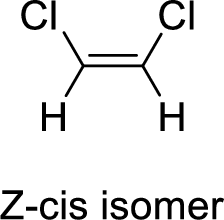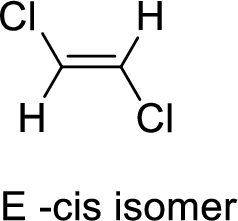
Bundle: Chemistry: The Molecular Science, 5th, Loose-Leaf + OWLv2 with Quick Prep 24-Months Printed Access Card
5th Edition
ISBN: 9781305367487
Author: John W. Moore, Conrad L. Stanitski
Publisher: Cengage Learning
expand_more
expand_more
format_list_bulleted
Concept explainers
Question
Chapter 6.5, Problem 6.5CE
Interpretation Introduction
Interpretation:
The cis isomer and the trans isomer of the maleic acid and fumaric acid has to be identified.
Concept Introduction:
It is under the class ofgeometric isomer. It exists inalkenes(organic molecules which have double bonds). Whentwo similar or higher priority groups are attached to the carbon on the same side,it is termed asCisisomer and when it is attached to theopposite sideit is called asTransisomer.
Cis isomers are termed as z-isomer and Tran’s isomers are termed as E-isomer.


Expert Solution & Answer
Want to see the full answer?
Check out a sample textbook solution
Students have asked these similar questions
Highlight each glycosidic bond in the molecule below. Then answer the questions in the table under the drawing area.
HO-
HO-
-0
OH
OH
HO
NG
HO-
HO-
OH
OH
OH
OH
NG
OH
€
+
Suppose the molecule in the drawing area below were reacted with H₂ over a platinum catalyst. Edit the molecule to show what would happen to it. That is, turn
it into the product of the reaction.
Also, write the name of the product molecule under the drawing area.
Name: ☐
H
C=0
X
H-
OH
HO-
H
HO-
-H
CH₂OH
×
Draw the Haworth projection of the disaccharide made by joining D-glucose and D-mannose with a ẞ(1-4) glycosidic bond. If the disaccharide has more than
one anomer, you can draw any of them.
Click and drag to start drawing a
structure.
X
Chapter 6 Solutions
Bundle: Chemistry: The Molecular Science, 5th, Loose-Leaf + OWLv2 with Quick Prep 24-Months Printed Access Card
Ch. 6.2 - Write Lewis structures for (a) NF3, (b) N2H4, and...Ch. 6.3 - Prob. 6.1ECh. 6.3 - Prob. 6.2PSPCh. 6.4 - Prob. 6.2CECh. 6.4 - Write Lewis structures for (a) nitrosyl ion, NO+;...Ch. 6.5 - Prob. 6.4CECh. 6.5 - Prob. 6.5CECh. 6.5 - Prob. 6.4PSPCh. 6.6 - Prob. 6.5PSPCh. 6.6 - Use Equation 6.1 and values from Table 6.2 to...
Ch. 6.6 - Prob. 6.6CECh. 6.7 - Prob. 6.7PSPCh. 6.7 - Prob. 6.7CECh. 6.8 - Prob. 6.8PSPCh. 6.9 - Prob. 6.9PSPCh. 6.9 - Prob. 6.9CECh. 6.10 - Prob. 6.10PSPCh. 6.11 - Prob. 6.10ECh. 6.11 - Prob. 6.11ECh. 6.11 - Prob. 1CECh. 6.11 - Prob. 2CECh. 6.12 - Repeat Problem-Solving Example 6.11, but use N2...Ch. 6.12 - Use MO theory to predict the bond order and the...Ch. 6 - Prob. 1QRTCh. 6 - Prob. 2QRTCh. 6 - Prob. 3QRTCh. 6 - Prob. 4QRTCh. 6 - Prob. 5QRTCh. 6 - Prob. 6QRTCh. 6 - Which of these molecules have an odd number of...Ch. 6 - Prob. 8QRTCh. 6 - Prob. 9QRTCh. 6 - Prob. 10QRTCh. 6 - Prob. 11QRTCh. 6 - Prob. 12QRTCh. 6 - Explain in your own words why the energy of two H...Ch. 6 - Prob. 14QRTCh. 6 - Prob. 15QRTCh. 6 - Prob. 16QRTCh. 6 - Prob. 17QRTCh. 6 - Prob. 18QRTCh. 6 - Prob. 19QRTCh. 6 -
Write Lewis structures for
tetracyanoethene,...Ch. 6 - Prob. 21QRTCh. 6 - Prob. 22QRTCh. 6 - Prob. 23QRTCh. 6 - Prob. 24QRTCh. 6 - Prob. 25QRTCh. 6 - Prob. 26QRTCh. 6 - Prob. 27QRTCh. 6 - Prob. 28QRTCh. 6 - Prob. 29QRTCh. 6 - For each pair of bonds, predict which is the...Ch. 6 - Prob. 31QRTCh. 6 - Prob. 32QRTCh. 6 - Which bond requires more energy to break: the...Ch. 6 -
Estimate ΔrH° for forming 2 mol ammonia from...Ch. 6 - Prob. 35QRTCh. 6 - Light of appropriate wavelength can break chemical...Ch. 6 - Prob. 37QRTCh. 6 - Prob. 38QRTCh. 6 - Prob. 39QRTCh. 6 - Acrolein is the starting material for certain...Ch. 6 - Prob. 41QRTCh. 6 - Prob. 42QRTCh. 6 - Write the correct Lewis structure and assign a...Ch. 6 - Prob. 44QRTCh. 6 - Prob. 45QRTCh. 6 - Two Lewis structures can be written for nitrosyl...Ch. 6 - Prob. 47QRTCh. 6 - Prob. 48QRTCh. 6 - Prob. 49QRTCh. 6 - Prob. 50QRTCh. 6 - Several Lewis structures can be written for...Ch. 6 - Prob. 52QRTCh. 6 - Prob. 53QRTCh. 6 - Prob. 54QRTCh. 6 - Prob. 55QRTCh. 6 - Draw resonance structures for each of these ions:...Ch. 6 - Three known isomers exist of N2CO, with the atoms...Ch. 6 - Write the Lewis structure for (a) BrF5 (b) IF5 (c)...Ch. 6 - Write the Lewis structure for
BrF3
XeF4
Ch. 6 - Prob. 60QRTCh. 6 - Prob. 61QRTCh. 6 - Prob. 62QRTCh. 6 - All carbon-to-carbon bond lengths are identical in...Ch. 6 - Prob. 64QRTCh. 6 - Prob. 65QRTCh. 6 - Prob. 66QRTCh. 6 - Prob. 67QRTCh. 6 - Prob. 68QRTCh. 6 - Prob. 69QRTCh. 6 - Prob. 70QRTCh. 6 - Using just a periodic table (not a table of...Ch. 6 - The CBr bond length in CBr4 is 191 pm; the BrBr...Ch. 6 - Prob. 73QRTCh. 6 -
Acrylonitrile is the building block of the...Ch. 6 - Prob. 75QRTCh. 6 - Write Lewis structures for (a) SCl2 (b) Cl3+ (c)...Ch. 6 - Prob. 77QRTCh. 6 - Prob. 78QRTCh. 6 - A student drew this incorrect Lewis structure for...Ch. 6 - This Lewis structure for SF5+ is drawn...Ch. 6 - Tribromide, Br3, and triiodide, I3, ions are often...Ch. 6 - Explain why nonmetal atoms in Period 3 and beyond...Ch. 6 - Prob. 83QRTCh. 6 - Prob. 84QRTCh. 6 - Prob. 85QRTCh. 6 - Prob. 86QRTCh. 6 - Which of these molecules is least likely to exist:...Ch. 6 - Write the Lewis structure for nitrosyl fluoride,...Ch. 6 - Prob. 91QRTCh. 6 - Methylcyanoacrylate is the active ingredient in...Ch. 6 - Aspirin is made from salicylic acid, which has...Ch. 6 - Prob. 94QRTCh. 6 - Prob. 95QRTCh. 6 - Prob. 96QRTCh. 6 - Prob. 97QRTCh. 6 - Prob. 98QRTCh. 6 - Nitrosyl azide, N4O, is a pale yellow solid first...Ch. 6 - Write the Lewis structures for (a) (Cl2PN)3 (b)...Ch. 6 - Nitrous oxide, N2O, is a linear molecule that has...Ch. 6 - The azide ion, N3, has three resonance hybrid...Ch. 6 - Hydrazoic acid, HN3, has three resonance hybrid...Ch. 6 - Prob. 104QRTCh. 6 - Experimental evidence indicates the existence of...Ch. 6 - Prob. 106QRTCh. 6 - Prob. 107QRTCh. 6 - Pipeline, the active ingredient in black pepper,...Ch. 6 - Sulfur and oxygen form a series of 2 anions...Ch. 6 - Prob. 110QRTCh. 6 - Prob. 111QRTCh. 6 - Prob. 112QRTCh. 6 - Prob. 113QRTCh. 6 - Prob. 114QRTCh. 6 - Prob. 115QRTCh. 6 - Prob. 116QRTCh. 6 - Prob. 117QRTCh. 6 - Prob. 118QRTCh. 6 - Prob. 6.ACPCh. 6 - Prob. 6.BCPCh. 6 - Prob. 6.CCP
Knowledge Booster
Learn more about
Need a deep-dive on the concept behind this application? Look no further. Learn more about this topic, chemistry and related others by exploring similar questions and additional content below.Similar questions
- Epoxides can be opened in aqueous acid or aqueous base to produce diols (molecules with two OH groups). In this question, you'll explore the mechanism of epoxide opening in aqueous acid. 2nd attempt Be sure to show all four bonds at stereocenters using hash and wedge lines. 0 0 Draw curved arrows to show how the epoxide reacts with hydronium ion. 100 +1: 1st attempt Feedback Be sure to show all four bonds at stereocenters using hash and wedge lines. See Periodic Table See Hint H A 5 F F Hr See Periodic Table See Hintarrow_forward03 Question (1 point) For the reaction below, draw both of the major organic products. Be sure to consider stereochemistry. > 1. CH₂CH₂MgBr 2. H₂O 3rd attempt Draw all four bonds at chiral centers. Draw all stereoisomers formed. Draw the structures here. e 130 AN H See Periodic Table See Hint P C Brarrow_forwardYou may wish to address the following issues in your response if they are pertinent to the reaction(s) you propose to employ:1) Chemoselectivity (why this functional group and not another?) 2) Regioselectivity (why here and not there?) 3) Stereoselectivity (why this stereoisomer?) 4) Changes in oxidation state. Please make it in detail and draw it out too in what step what happens. Thank you for helping me!arrow_forward
- 1) Chemoselectivity (why this functional group and not another?) 2) Regioselectivity (why here and not there?) 3) Stereoselectivity (why this stereoisomer?) 4) Changes in oxidation state. Everything in detail and draw out and write it.arrow_forwardCalculating the pH at equivalence of a titration 3/5 Izabella A chemist titrates 120.0 mL of a 0.7191M dimethylamine ((CH3)2NH) solution with 0.5501 M HBr solution at 25 °C. Calculate the pH at equivalence. The pk of dimethylamine is 3.27. Round your answer to 2 decimal places. Note for advanced students: you may assume the total volume of the solution equals the initial volume plus the volume of HBr solution added. pH = ☐ ✓ 18 Ar Boarrow_forwardAlcohols can be synthesized using an acid-catalyzed hydration of an alkene. An alkene is combined with aqueous acid (e.. sulfuric acid in water). The reaction mechanism typically involves a carbocation intermediate. > 3rd attempt 3343 10 8 Draw arrows to show the reaction between the alkene and hydronium ion. that 2nd attempt Feedback 1st attempt تعمال Ju See Periodic Table See Hint F D Ju See Periodic Table See Hintarrow_forward
- Draw the simplified curved arrow mechanism for the reaction of acetone and CHgLi to give the major product. 4th attempt Π Draw the simplified curved arrow mechanism T 3rd attempt Feedback Ju See Periodic Table See Hint H -H H -I H F See Periodic Table See Hintarrow_forwardSelect the correct reagent to accomplish the first step of this reaction. Then draw a mechanism on the Grignard reagent using curved arrow notation to show how it is converted to the final product. 4th attempt Part 1 (0.5 point) Select the correct reagent to accomplish the first step of this reaction. Choose one: OA Mg in ethanol (EtOH) OB. 2 Li in THF O C. Li in THF D. Mg in THF O E Mg in H2O Part 2 (0.5 point) Br Part 1 Bri Mg CH B CH, 1 Draw intermediate here, but no arrows. © TE See Periodic Table See Hint See Hint ין Harrow_forwardSelect the product for the following reaction. HO HO PCC OH ○ OH O HO ○ HO HO HOarrow_forward
- 5:45 Х Select the final product for the following reaction sequence. O O 1. Mg. ether 2.D.Oarrow_forwardBased on the chart Two similarities between the molecule with alpha glycosidic linkages. Two similarities between the molecules with beta glycosidtic linkages. Two differences between the alpha and beta glycosidic linkages.arrow_forwardplease help fill in the tablearrow_forward
arrow_back_ios
SEE MORE QUESTIONS
arrow_forward_ios
Recommended textbooks for you
 Chemistry: The Molecular ScienceChemistryISBN:9781285199047Author:John W. Moore, Conrad L. StanitskiPublisher:Cengage Learning
Chemistry: The Molecular ScienceChemistryISBN:9781285199047Author:John W. Moore, Conrad L. StanitskiPublisher:Cengage Learning ChemistryChemistryISBN:9781305957404Author:Steven S. Zumdahl, Susan A. Zumdahl, Donald J. DeCostePublisher:Cengage Learning
ChemistryChemistryISBN:9781305957404Author:Steven S. Zumdahl, Susan A. Zumdahl, Donald J. DeCostePublisher:Cengage Learning Chemistry: An Atoms First ApproachChemistryISBN:9781305079243Author:Steven S. Zumdahl, Susan A. ZumdahlPublisher:Cengage Learning
Chemistry: An Atoms First ApproachChemistryISBN:9781305079243Author:Steven S. Zumdahl, Susan A. ZumdahlPublisher:Cengage Learning
 Chemistry & Chemical ReactivityChemistryISBN:9781337399074Author:John C. Kotz, Paul M. Treichel, John Townsend, David TreichelPublisher:Cengage Learning
Chemistry & Chemical ReactivityChemistryISBN:9781337399074Author:John C. Kotz, Paul M. Treichel, John Townsend, David TreichelPublisher:Cengage Learning Chemistry & Chemical ReactivityChemistryISBN:9781133949640Author:John C. Kotz, Paul M. Treichel, John Townsend, David TreichelPublisher:Cengage Learning
Chemistry & Chemical ReactivityChemistryISBN:9781133949640Author:John C. Kotz, Paul M. Treichel, John Townsend, David TreichelPublisher:Cengage Learning

Chemistry: The Molecular Science
Chemistry
ISBN:9781285199047
Author:John W. Moore, Conrad L. Stanitski
Publisher:Cengage Learning

Chemistry
Chemistry
ISBN:9781305957404
Author:Steven S. Zumdahl, Susan A. Zumdahl, Donald J. DeCoste
Publisher:Cengage Learning

Chemistry: An Atoms First Approach
Chemistry
ISBN:9781305079243
Author:Steven S. Zumdahl, Susan A. Zumdahl
Publisher:Cengage Learning


Chemistry & Chemical Reactivity
Chemistry
ISBN:9781337399074
Author:John C. Kotz, Paul M. Treichel, John Townsend, David Treichel
Publisher:Cengage Learning

Chemistry & Chemical Reactivity
Chemistry
ISBN:9781133949640
Author:John C. Kotz, Paul M. Treichel, John Townsend, David Treichel
Publisher:Cengage Learning